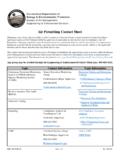Transcription of Volume 0, Number 0 No Date Prototype Issue - Up …
1 Volume 0, Number 0No DatePrototype Issue2 Northrop Flying Wings Design Concepts - 1950 Northrop Aircraft, Inc. was always interested in the flying wing concept. Jack Northrop s dreamwas realized in 1946 when the first XB-35 took to the air. However, the piston engined B-35 and its jet-engined sibling B-49 were destined to not achieve production status. There were a Number of factorsstanding in the way of success for the flying wings. They were unconventional configurations, and weregoing up against the giant but relatively conventional Consolidated prejudice againstunconventional aircraft was firmly entrenched, and the Northrop corporation did not have the political cloutof their competition.
2 But perhaps most telling, the flying wings had their bomb loads distributed throughseveral smaller bomb bays, rather than one central, large by. While this would have proven an irrelevancyin World War II with a load of conventional bombs, in the late 1940 s the USAF was looking at fielding thelatest generation of hydrogen bombs. These weapons were giant devices that simply would not fit withinthe confines of the B-35 s small bomb bays. In 1950, several designs were unveiled for new flying wing bombers. These aircraft wereadvancements upon existing B-35 and B-49 flying wing bomber designs, using somewhat differentplanforms (including cockpits that projected well ahead of the wing leading edge) and taking advantage ofnew, powerful turboprop engine designs.
3 But perhaps the greatest advance over the previous flying wingswas the use of something that more closely approximated a providing the Volume to carry asingle multi-megaton citybuster. The design chosen was an update of an earlier Northrop concept, datingfrom drawing of a flying wing design patent filed for in 1941A crew of five was contemplated for these designs, with two crewmembers in a tandem cockpit(similar to the Boeing B-47). Two other seats were located in the leading edges of the wing roots, and wereprovided with large windows for forward visibility. A tail stinger was provided with a remote gun turretcontaining two or four machineguns (probably.)
4 50 caliber). Inflight refueling was planned for long rangebomb runs; speed and maneuverability were expected to be such that fighter interception would beextremely primary version was equipped with two Turbodyne V turboprop engines, each driving a six-bladed counter-rotating propeller. The Turbodyne was a large turboprop engine developed in-house atNorthrop; each engine could put out 10,000 : feet/ metersLength: feet/ metersMaximum ground weight: 161,540 ,427 kgMaximum flight weight (after inflight refueling): 222,710 ,232 kgCruising speed: 450 knotsBombing altitude: 43,000 feetCombat radius - unrefueled: 2,400 n. radius - refueled at cruising altitude: 4,500 n.
5 Radius - refueled 1000 n. mi. from base: 4,850 n. of Turbodyne V versionCutaway view of Turbodyne V version4 Artists impression of Turbodyne V versionThe alternate version was equipped with four Allison XT 40 turboprops, providing a total of 30,000 shafthorsepower. The propeller arrangement was divided into four six-bladed counter-rotating props. Otherwisethe design was essentially identical to the Turbodyne V variant. Performance was lower than that of theTurbodyne V : feet/ metersLength: feet/ metersMaximum ground weight: 175,400 ,727 kgMaximum flight weight (after inflight refueling): 212,100 ,409 kgCruising speed: 440 knotsBombing altitude: 37,000 feetCombat radius - unrefueled: 2,400 n.
6 Radius - refueled at cruising altitude: 3,500 n. of alternate version5 Cutaway view of alternate versionArtists impression of alternate versionArtists impressions of slightly different versions of the turboprop flying XB-68 One bomber that received the B- Number but not the production go-ahead was the Martin mid-1950's tactical bomber has been previously described as a three-engined delta winged aircraftsimilar in design to the Convair B-58 "Hustler" (see Lloyd Jones, Bombers, 1928 to 1980 s, AeroPublishers, Inc., 1980). However, information has been found that shows a completely different confusion is likely due to different designs being studied to perform the same XB-68 described here, Martin Model 316, was a twin-engine design of relativelyconventional layout, looking as much like a contemporary fighter as a bomber (however, the resemblanceto the stillborn Boeing B-59 is remarkable).
7 A slender fuselage was flanked by the long engine nacelles,each equipped with inlets that would have looked at home on the MiG 25 or the F-15. Relatively low aspectratio, moderately swept wings were mid-mounted to the nacelles. A swept T-tail provided stability at therear, mounted above the radar-controlled tail gear was similar to the Boeing B-47 in having two sets of main gear in tandem, withoutriggers in wingtip pods. The fuselage was packed with fuel tanks, even though the range was ratherlimited (it is unknown if in-flight refueling was considered). Cruise to the target was to be subsonic and athigh altitude, but the bomb run dash was to be conducted at supersonic speed and at even higher bombs were to be stored in a rotary bomb bay (used on the Martin B-57 Canberra).
8 Two decelerationparachutes were included for crew of two were used on this aircraft: a pilot-radio operator and a navigator-bombardier-defense systems operator. The tandem cockpit was pressurized and cooled by a refrigeration unit while athigh Mach numbers. The aircraft was built mainly of steel and rated to a skin temperature of 350 of the Martin B-687 Data for XB-688 Martin XB-68 DataCutaway view of Martin XB-68 Locations of fuel, oil and water/alcohol tanks9 Kaiser Tailless AirplaneOne little known and poorly documented aircraft was known as the Kaiser Tailless Airplane. While information available to the author is extremely limited, it appears that the Kaiser Tailless Airplanewas designed for Henry Kaiser, the American industrialist who produced the Liberty Ships during WorldWar II.
9 In 1942, Kaiser proposed using very large flying boats to ferry troops and supplies from the US toBritain, bypassing the dreaded German U-Boat wolfpacks. Kaiser formed a partnership with howardHughes to produce the HK-1 Hercules (the Spruce Goose ), but it appears that Kaiser had at least oneother design Kaiser Tailless Airplane was a flying wing of somewhat unconventional layout. Thewing was given minimal dihedral; the trailing edge swept forward more steeply than the leading edge sweptback, giving the vehicle almost the appearance of forward sweep. Four piston engines were mounted wellforward of the wing centerbody, with a large dorsal fin directly aft of each engine.
10 A cockpit bubbleappears above the wing centerline. The full scale vehicle was to have a span of 290 feet/ meters, awing area of 7920 square feet/ 736 sqaure meters, and a gross weight of 175,000 pounds/ 79,545 1/7 scale wind tunnel model, built by Kaiser Cargo, Inc. was supplied to Langley Field,Virginia, for wind tunnel testing. The results were reported in March of Arrangement of the Wind Tunnel ModelPhotos of the Wind Tunnel Model (Note Canopy)Reference: C. Brewer, E. Rickey, Tests of the 1/7-Scale Powered Model of the Kaiser Tailless Airplane in the LangleyFull-Scale Tunnel, NACA Langley Memorial Aeronautical Laboratory, Memorandum Report L6C13, March, 194610 Boeing VTOL Intercity TransportFor a NASA study on short-haul commercialtransport, Boeing designed a Number of short andvertical take-off aircraft.





